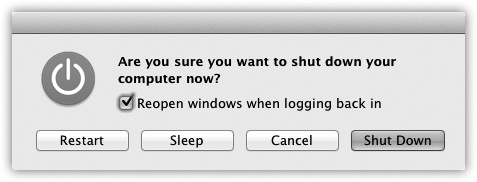If you’re the only person who uses your Mac, finishing up a work session is simple. You can either turn off the machine or simply let it go to sleep, in any of several ways.
Apple expects its customers not to shut down their machines between sessions, and that’s fine. Instead, you’re encouraged to use sleep mode (formerly called Standby on the PC). Sleep mode consumes very little power, keeps everything you were doing open and in memory, and wakes the Mac almost immediately when you press a key or click the mouse. To make your machine sleep, use any of these techniques:
Close the lid. (Hint: This tip works only on laptops.)
Press Control-.
 (or Control-F12, if you don’t have a
(or Control-F12, if you don’t have a
 key). In the dialog box shown in Figure 1-4, click
Sleep (or type S).
key). In the dialog box shown in Figure 1-4, click
Sleep (or type S).Press the power button (.
 ) on your
machine. On desktop models, doing so makes it sleep
immediately; on laptops, you get the dialog box shown in Figure 1-4.
) on your
machine. On desktop models, doing so makes it sleep
immediately; on laptops, you get the dialog box shown in Figure 1-4.Just walk away, confident that the Energy Saver setting described in Color Tab will send the machine off to dreamland automatically at the specified time.
You shouldn’t have to restart the Mac very often—only in times of severe troubleshooting mystification, in fact. Here are a few ways to do it:
Choose
 →Restart. A confirmation dialog box
appears; click Restart (or press Return).
→Restart. A confirmation dialog box
appears; click Restart (or press Return).Press Control-
 -
- . (If you don’t have that key, substitute
F12.)
. (If you don’t have that key, substitute
F12.)Press Control-
 to summon the dialog box shown in Figure 1-4; click
Restart (or type R).
to summon the dialog box shown in Figure 1-4; click
Restart (or type R).
To shut down your machine completely (when you don’t plan to use it for more than a couple of days, when you plan to transport it, and so on), do one of the following:
Choose
 →Shut
Down. A simple confirmation dialog box appears; click
Shut Down (or press Return).
→Shut
Down. A simple confirmation dialog box appears; click
Shut Down (or press Return).Press Control-Option-
 -
- . (It’s not as complex as it looks—the
first three keys are all in a tidy row to the left of the space
bar.)
. (It’s not as complex as it looks—the
first three keys are all in a tidy row to the left of the space
bar.)Press Control-
 (or
Control-F12) to summon the dialog box shown in Figure 1-4. Click
Shut Down (or press Return).
(or
Control-F12) to summon the dialog box shown in Figure 1-4. Click
Shut Down (or press Return).Wait. If you’ve set up the Energy Saver preferences (Color Tab) to shut down the Mac automatically at a specified time, then you don’t have to do anything.
In the Shut Down dialog box illustrated in Figure 1-4, you’ll notice one of Lion’s most-hyped new features: a checkbox called “Reopen windows when logging back in.” That simple box does something very useful: The next time you start up your Mac, every running program, and every open window, will reopen exactly as it was at the moment you used the Restart or Shut Down command. The new option gives the Mac something like the old Hibernate feature in Windows—and saves you a lot of reopening the next time you sit down to work.
If you turn off that checkbox when you click Restart or Shut
Down, then your next startup will take you to the desktop, with no
programs running, as though this were still some year between 1984
and 2010. And if you want the Mac to stop asking—if you never want
your programs and windows to reopen—then open ![]() →System Preferences→General and turn off
“Restore windows when quitting and re-opening apps.”
→System Preferences→General and turn off
“Restore windows when quitting and re-opening apps.”
If you share your Mac with other people, then you should
log out when you’re done. Doing so ensures that
your stuff is safe from the evil and the clueless when you’re out of
the room. To do it, choose ![]() →Log Out (or press Shift-
→Log Out (or press Shift-![]() -Q). When the confirmation dialog box appears,
click Log Out, press Return, or just wait for 2 minutes. The Mac
hides your world from view and displays the login dialog box, ready
for its next victim.
-Q). When the confirmation dialog box appears,
click Log Out, press Return, or just wait for 2 minutes. The Mac
hides your world from view and displays the login dialog box, ready
for its next victim.
Another option is to use fast user switching—a feature that lets you switch from one user to another without actually logging out, just as in Windows. With fast user switching turned on, your Mac can have several people logged in at once, although only one person at a time actually sees his own desktop.
In either case, this whole accounts system is described in much more detail in Chapter 14.
Get Switching to the Mac: The Missing Manual, Lion Edition now with the O’Reilly learning platform.
O’Reilly members experience books, live events, courses curated by job role, and more from O’Reilly and nearly 200 top publishers.


